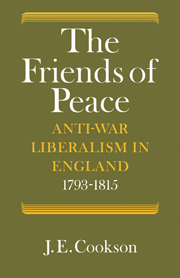Book contents
8 - YORKSHIRE AND LANCASHIRE
Published online by Cambridge University Press: 07 October 2011
Summary
After the petitions of 1797, largely engineered by the Whigs, protest against the war remained heavily concentrated in the manufacturing districts of the Midlands and North. In 1801 peace petitions came from Leeds, Bradford and Wakefield. In 1807–8 the West Riding towns were again prominent, but they were joined by Bolton, Stock-port, Oldham and Manchester. In 1812–13 peace petitioning originated in the East Midlands ‘hosiery district’ and spread from there to Leeds and the Potteries. No other part of the country, not even the metropolis with its growing radical force, showed a comparable interest in the issue of war and peace. The strength of anti-war feeling in the manufacturing districts shows the extent to which they had become enclaves within the old society. Not only did their demand for peace run against the dominant view that the war was a struggle for survival, but their leadership was also self-provided, ignoring the usual dependencies of the social hierarchy, and their mode of proceeding was towards a horizontal solidarity of local communities and ‘districts’ instead of along the vertical line leading from constituted authority at the local level to constituted authority at the national level. The formation of regional identities above county and town, and even of a supra-regional identity founded on provincialism and industrialism, was to be clearly seen in 1812 with the campaign against the Orders in Council. On this occasion, the ‘hardware districts’ centred on Sheffield and Birmingham, the ‘textile districts’ of Lancashire and the West Riding, the Potteries and the great seaport towns of Liverpool and Hull were mobilised by local men and achieved a remarkable degree of co-operation.
- Type
- Chapter
- Information
- The Friends of PeaceAnti-War Liberalism in England 1793–1815, pp. 186 - 214Publisher: Cambridge University PressPrint publication year: 1982



